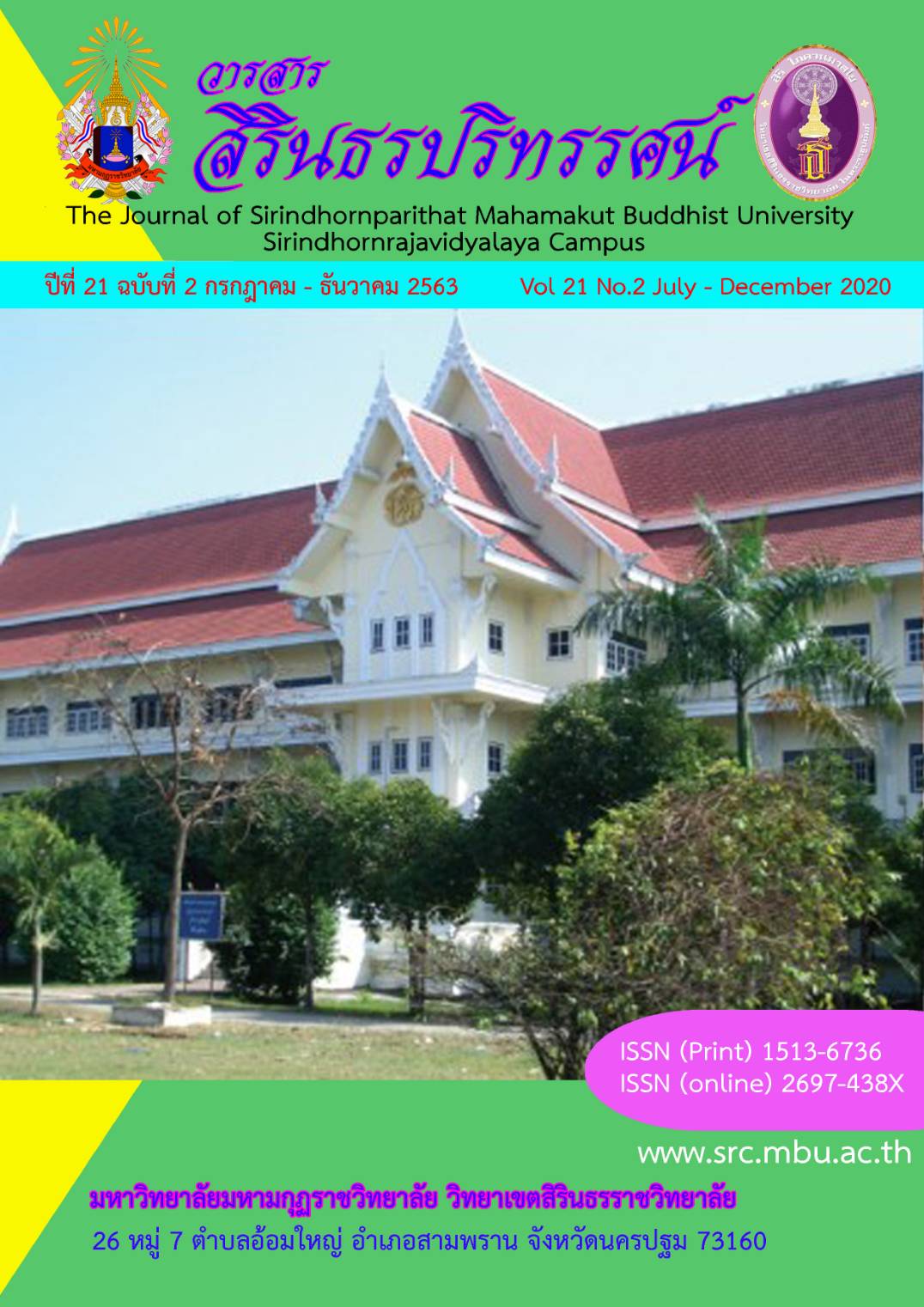The Role of Buddhist Monastery toward Thai society in an inscription of The great king Ramkhamhaeng.
Keywords:
Role of Buddhist Monastery, Thai Society, Inscription of King Ramkhamhaeng the Great.Abstract
The current academic article presents the role of the Buddhist monastery (Wat) with a major special reference to the inscription of King Ramkhamhaeng, the Great. The objective of the article is to analyze the role of Wat in the Thai society context only according to the background and history of the Thai nation study based on a comprehensive study on Thai history as the original of Wat in early Buddhism. The Ramkhamhaeng Inscription is a stone tablet recording historical events in the Sukhothai period. The remarkable role of Wat is represented as the accommodation of Buddhist monks such as senior monks Nissayamuttaka, Theras, and Mahatheras. In the spiritual, the role of Wat was the center of the king, princes, princess, also layman and laywoman to pay homage to the Buddha statues. Furthermore, they practice and learn Dhamma and observe the precepts such as the five or eight rules of morality. The study was found that Wat in the inscription of the King Ramkhamhaeng, the Great can be defined into 8 dimensions consist of (1) accommodation, (2) spiritual, (3) geography, (4) education, (5) social, (6) culture, (7) Architecture, (8) Museum.
References
Charounwong Pisit. (2019). “Thai Encyclopedia for Youth By His Majesty King Bhumibol Adulyadej's reign”. Volume 16. 1975. E-book accessed: 13 July 2019.
Chulalongkorn University ed. (1984). The Inscription of King Ramkamhaeng the Great, the 700th Anniversary of the Thai Alphabet. Bangkok: Chulalongkorn University.
Dutt Sukumar. (2008). Buddhist Monks and Monasteries of India: Their History and Their Contribution to Indian Culture. Press: Motilal Banarsidass Publishers. Delhi.
Goode William J., ed. (2011). The Dynamics of Modern Society. Aldine Transaction A Division of Transaction Publishers. New Brunswick U.S.A. and London U.K.
He Liqun. (2013). “Buddhist State Monasteries in Early Medieval China and their Impact on East Asia”. Dissertation Doctor of Philosophy. Institute of East Asian Art History, Heidelberg University. Germany.
Keown, and Damien. (2013). “Buddhism: A Very Short Introduction”. Press: Oxford University. Oxford. p. 80.
Kamyong Phrakhruchinawalanuwat. (2011). “The Roles of Temples Towards the Public Welfare: A Case study of Bankongnoi, Ratchaburi Province” Thesis Master of Arts in Buddhist Management, Graduate School, Mahachulalongkornrajavidyalaya University.
Khanjanusthiti Pinraj. (1996). “Buddhist Architecture: Meaning and Conservation in the Context of Thailand”. Dissertation Doctor of Philosophy. Institute of Advanced Architectural Studies. The University of York.
Khantipalo Bhikkhu. (1982). “Lay Buddhist Practice: The Shrine Room, Uposatha Day, Rains Residence: The Wheel No. 206/207”. Kandy, Sri Lanka: Buddhist Publication.Online: http://www.accesstoinsight.org/lib/authors/khantipalo/wheel206.html
Kohlbacher. (2006). “The Use of Qualitative Content Analysis in Case Study Research”. Journalist: FQS. Forum: Qualitative Social Research Sozialforschung. Volume 7. No.1. Art. 21. January 2006.
Landon Kenneth P. (2020.) “Southeast Asia, Crossroads of Religion”. Chicago. 1947. pp. 90-95. Folder 2, Sino-American Detente and Its Implications for Southeast Asia, Box: 122, Folder: 2. Margaret and Kenneth P. Landon Papers, SC-038. Buswell Library Special Collections.
https://archives.wheaton.edu/repositories/2/archival_objects/167904 Accessed November 16, 2020.
Meshram Manish, (2003). “Role of Buddhist Education In Ancient India”. Impact: International Journal of Research in Humanities, Arts, and Literature (IMPACT: IJRHAL). Vol. 1, Issue 3, Aug 2013, 7-16.
Nash Manning, Gananath Obeyesekere, Michael M. Arnes, et al, (2007) “Anthropological Studies in Theravada Buddhism Central Report Series”. Issue 13, Southeast Asia Studies, Yale University., 1966. p.p. 72-74, 112-115 and 175-191. E: Book
P.V. Bapat. (2012). 2500 years of Buddhism. 8th ed. Motilal Banarsidass. India.
Raksaphol Siripattra. (2016). “Wat Prayurawongsawas Warawihan’s Role to Promote Multicultural of Tourism Community Based on Buddhist Peaceful Means”. Dissertation Master of Art in Peace Studies. Graduate School, Mahachulalongkornrajavidyalaya University. Bangkok. Thailand.
Roy Edward Van. (2017). Siamese Melting Pot: Ethnic Minorities in the Making of Bangkok. ISEAS, Yusof Ishak Institute. Silkworm Books Press. Chiang Mai. Thailand.
Saengsutho Nitiphum, and Supinit Vijit. (2016). “The Thai Temple: A case study of Watprayurawongsawas Bangkok, Thailand”. Projects research at Siam University. International Journal of Thesis Projects and Dissertations (IJTPD) Vol. 4, Issue 2. Month: April - June 2016. Bangkok. Thailand. p.p. 275-282. Online: www.researchpublish.com
Terwiel Barend Jan. (2010). “The Ram Khamhaeng Inscription: The fake that did not come true” Redaktion, Satz und Umschlaggestaltung: Martin Hanke und Dorothee Schaab-Hanke Druck und Bindung: Rosch-Buch Druckerei GmbH, Scheblitz Printed in Germany.
Tim’s Thailand. “Thai Culture, Food, and Travel: History About the Ramkhamhaeng Inscription”. Online: https://www.timsthailand.com/category/buddhism/.
Veerapak Kongkaew, (2019). “Thai Encyclopedia for Youth By His Majesty King Bhumibol Adulyadej's reign”. Volume 16. 1975. E-book accessed: 13 July 2019.
Downloads
Published
Issue
Section
License
บทความที่ได้รับการตีพิมพ์เป็นลิขสิทธิ์ของ มหาวิทยาลัยมหามกุฏราชวิทยาลัย วิทยาเขตสิรินธรราชวิทยาลัย
ข้อความที่ปรากฏในบทความแต่ละเรื่องในวารสารวิชาการเล่มนี้เป็นความคิดเห็นส่วนตัวของผู้เขียนแต่ละท่านไม่เกี่ยวข้องกับหาวิทยาลัยมหามกุฏราชวิทยาลัย วิทยาเขตสิรินธรราชวิทยาลัย และคณาจารย์ท่านอื่นๆในมหาวิทยาลัยฯ แต่อย่างใด ความรับผิดชอบองค์ประกอบทั้งหมดของบทความแต่ละเรื่องเป็นของผู้เขียนแต่ละท่าน หากมีความผิดพลาดใดๆ ผู้เขียนแต่ละท่านจะรับผิดชอบบทความของตนเองแต่ผู้เดียว




